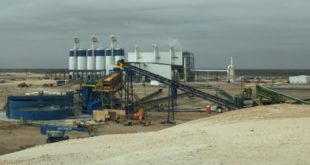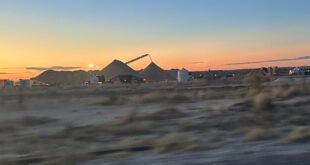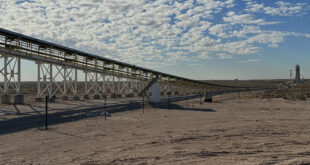Some Infill Thinking readers may have known the High Roller name even before the company became a player in the Permian Basin sand rush.
High Roller is the parent company of a diverse mix of oilfield businesses including waste water hauling, SWDs, sand transloading, and man camps. The firm is a private, family-run company that has been through the ups and downs of the oil business for more than 20 years.
While you may know the High Roller brand name in the oilfield, you may not know how the name came to be. It has nothing to do with Vegas, gambling, or bling. Instead, High Roller was a famous breeding buck from Pennsylvania known far and wide for producing exceptional whitetail trophy deer. Back in 2006, the family that controls the High Roller oilfield service group bought the buck post-mortem for his semen, which was used to populate a field of award winning whitetails that now occupy two high end hunting ranches in Center, Texas – High Roller Whitetails and Venado Creek. Then in 2009, they named their oilfield group High Roller. In 2017, the famous buck’s legacy extended into the frac sand business when High Roller ownership made a move on some dunes north of Kermit.
High Roller Sand made its first move in the Permian sand rush before it was a sand rush. The company’s start in frac sand goes back to last fall when they secured an option on their future site.
Backed by equity partner CSL Capital Management, High Roller laid claim to one of the largest contiguous mine properties in the Permian in-basin trend – an eight-section parcel close to the corner of Texas and New Mexico. They purchased the site outright so there will be no royalties to bite into contribution margin.
The 5,000+ acres High Roller owns will generate 100+ years of sand production (325mm+ tons of resource identified). Even after all that potential, there is still plenty of acreage left to dedicate to conservation (more on that later).
The company’s reserves are 50-140 mesh 9k crush broken down as follows:
- 45% API 40-70 mesh 6-8k crush
- 55% API 100 mesh 9-10k crush
High Roller’s gate is marked on the map below and their acreage extends three sections east of the gate. Alpine Silica is the only Permian mine that we know of positioned north of High Roller.

We were briefed by Dave Frattaroli, the company’s Executive Vice President, shortly before our visit to see the company’s future mine site in person last week. Before joining High Roller, Dave spent 30 years at Unimin. He told us: “We are in it to make sand for the long term. We are focused on mining our deposit in a responsible manner.” After hearing Dave outline the vision and seeing the site and its plan in person, we don’t doubt it.
The High Roller Site will have several advantages going for it. Here are five we see as worthy of a mention:
- Location logistics. The High Roller site will have low traffic routes into the Northern Delaware and Northern Midland Basins – both of which its shipments can access without moving into Kermit where mines to the south will be pushing thousands of trucks through per day. Because of their location, High Roller trucks won’t have to deal with many of the hidden delays we highlighted back in this update.
- With size comes logistics flexibility. And this flexibility starts with a massive access road. Three trucks could comfortably drive side-by-side down High Roller’s private site entry road (completed two weeks ago and being rocked this week). The road runs straight to their plant for about a mile and a half off 1218. They could easily line up several hundred trucks to wait on sand without highway overflow. The size of their swath of land also allows them some good flexibility in moving in and around the site – a luxury other smaller sites may find problematic as they switch on production and with it site congestion.
- Top quartile early mover. If everyone’s projects proceed on their schedules as set today, then High Roller will be the fourth Kermit-area producer to ship sand. They’ll be commissioning the facility in December and producing on January 15, 2018. The company had their reserves and long-lead time production equipment purchased by spring, before the sand rush had heated up. They broke ground on July 22, 2017 and were clearing land in preparation of excavation when we visited the site last week. Concrete is being poured this week or next, and construction will reach full stride, including 24/7 building, in 4Q17.
- Ample Water. At the time of our visit, two water wells were in place on site. Dave Frattaroli says their site was well known as a source of ranching water historically, and they feel good about the water they have on the property. High Roller has been pumping their first water well for a month, and it’s been more than sufficient so far per the company. In fact, High Roller is considering selling excess water.
- A proactive and thoughtful dune sagebrush lizard (DSL) risk mitigation strategy. For starters, it is important to note that High Roller’s plant itself doesn’t have a so-called “polygon problem.” Their property is so vast that some sections do fall into the Hibbits map “very high” probability area, but the company has spotted their processing facility and mining zone in a section that is entirely outside the map’s habitat zones. Their self-commissioned environmental survey found no evidence of DSL habitat in the area where they’ve spotted the plant. Even so, High Roller now plans to invest for many years to come in the creation of new DSL habitat on a portion of their large acreage position. They bought a huge amount of land, allowing them the capacity to set some aside. They’ve commissioned a state-recognized environmentalist to develop a plan to establish DSL habitat on their property. High Roller will furnish the plan to Dr. Gulley at the Comptroller’s office when it is finalized.

A map from High Roller’s site evaluation shows no DSL habitat in section 7 (where the processing plant is being built) and no habitat in section 8 including the dune areas in the northeast and southeast corners of section 8. High Roller will further perform an onsite evaluation of habitat in sections 1-6
We asked Dave Frattaroli if High Roller plans to expand capacity or build a second site given all the land they’ve got. He said their first site will be designed to produce up to 4mmtpa. While there are no firm plans for a second site, the company is in talks with several other parties about potential facilities on other areas of the northern part of their parcel. Even after all the announcements, there are still more folks interested in starting a mine (including operators, pressure pumpers, and other sand producers). We wouldn’t be surprised to see High Roller enter into a JV or partnership to eventually add another facility.
As Dave says: “The High Roller team and ownership is extremely open to working with customers to deliver customized solutions they want. We know the oilfield moves fast, and we will too.”
High Roller has secured take or pay customer commitments / contracts, but they aren’t asking for prepayments given their confidence in their own financial footing. Dave thinks “prepayments are just a way to put a hook in a customer. We are looking for partners not prey.” At the end of the day, High Roller wants to become a trusted sand supplier for a few partners (E&P or OFS) who are serious about their commitment to securing a long-term sand source through the cycles.
After speaking with Dave Frattaroli by phone, we had a chance to tour the site with Tony Abernathy, the plant’s construction manager. It was just Tony’s third week on the job, but he’s been doing this for just a little while (see street cred). He showed us the site plan, layout, and drove us around the facility.
While both Tony and Dave are positive on most fronts, one area they both expressed some concern about was labor. As we’ve written before, staffing these Kermit mines is going to be tough, and High Roller is well aware of the impending challenge. They are looking at some creative means of attracting workers including flexible schedules and a man camp / corporate housing arrangement.
In the table below, you’ll find facility specs and some takeaways on site specifics from our tour and briefing.
High Roller Plant Specs & Observations From Our Site Visit

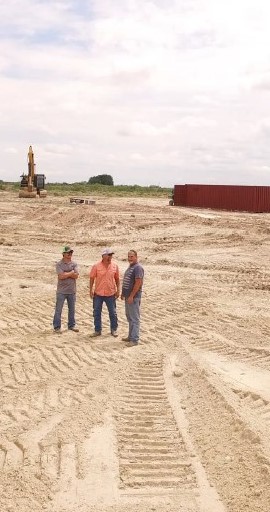
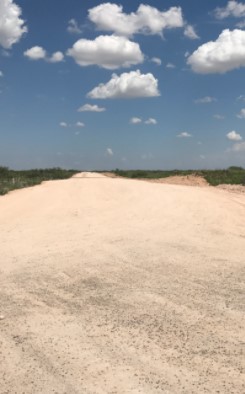
| Sections | 8 |
| Acres | ~5,100 |
| Reserve Size | 325mm+ tons |
| Reserve Life | 100+ years |
| Initial Capacity | 3mmtpa+ |
| Deposit Mix | 45% API 40-70 mesh 6-8k crush; 55% API 100 mesh 9-10k crush |
| Commission Date | December 15, 2017 |
| First Delivery | January 1, 2017 |
| Contracts | Have take or pay commitments; no upfront payments; project is capitalized |
| Plant Equipment & Configuration | Long-lead time gear ordered before rush: 6 silos (3,000k tons each), 3 dryers (custom blend capable), 12 Rotex screeners |
| Storage | Open damp sand storage with built-in water reclamation capability |
| Water Source | Two wells completed on site; ample supply; no third-party water needed |
| Loadout | <5 min per truck loadout in silo; <15 min per truck gate-to-gate |
| Design & Execution Partners | Indeco & Market & Johnson |
| Power | Gas and electric secured; building in a natural gas line |
| Status at time of visit | Land being cleared, site layout marked, excavation and foundation work scheduled to begin imminently followed by concrete pour |
 Infill Thinking Lifting the O&G knowledge curve
Infill Thinking Lifting the O&G knowledge curve

